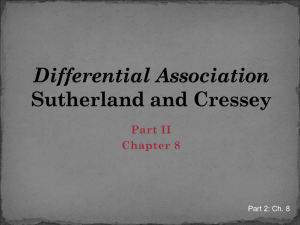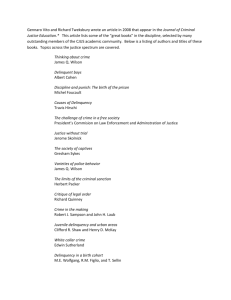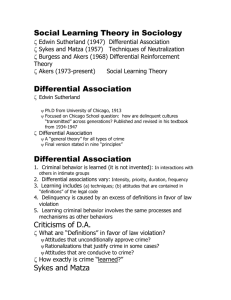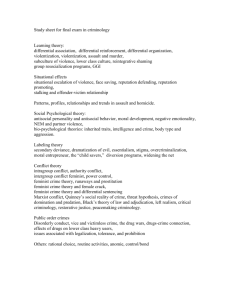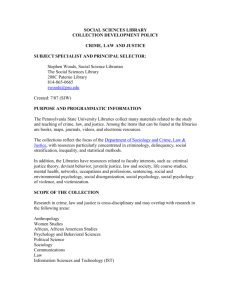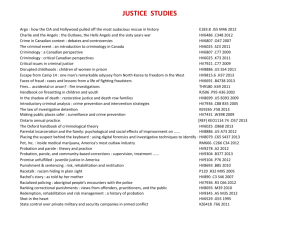"Criminology is the body of knowledge regarding delinquency and
advertisement
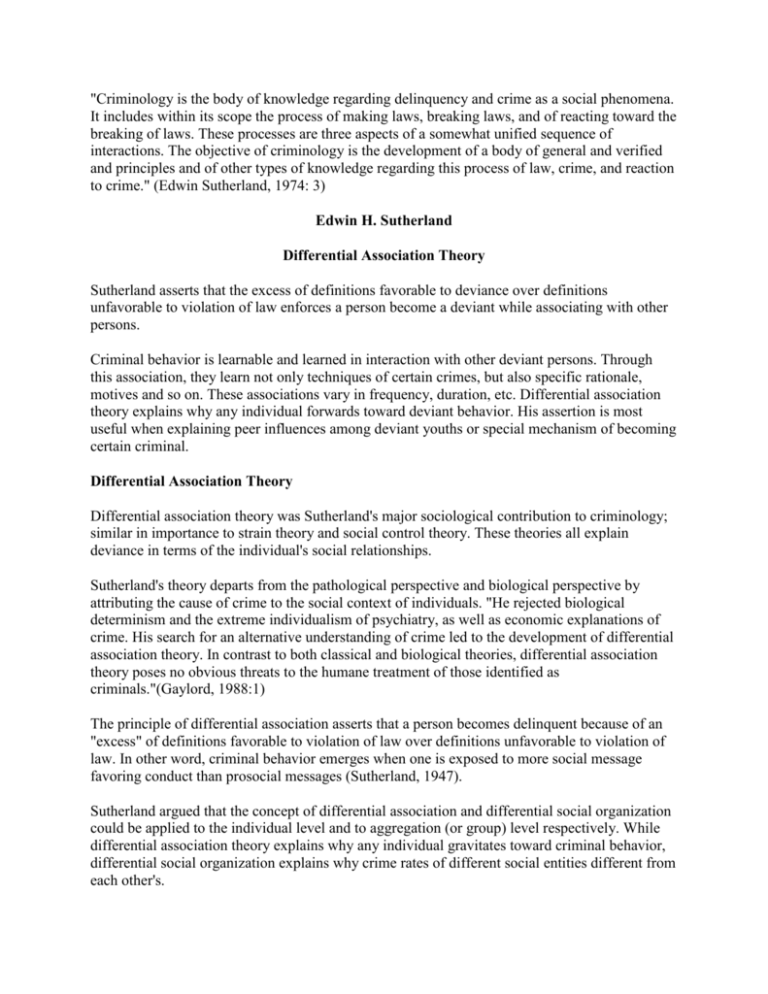
"Criminology is the body of knowledge regarding delinquency and crime as a social phenomena. It includes within its scope the process of making laws, breaking laws, and of reacting toward the breaking of laws. These processes are three aspects of a somewhat unified sequence of interactions. The objective of criminology is the development of a body of general and verified and principles and of other types of knowledge regarding this process of law, crime, and reaction to crime." (Edwin Sutherland, 1974: 3) Edwin H. Sutherland Differential Association Theory Sutherland asserts that the excess of definitions favorable to deviance over definitions unfavorable to violation of law enforces a person become a deviant while associating with other persons. Criminal behavior is learnable and learned in interaction with other deviant persons. Through this association, they learn not only techniques of certain crimes, but also specific rationale, motives and so on. These associations vary in frequency, duration, etc. Differential association theory explains why any individual forwards toward deviant behavior. His assertion is most useful when explaining peer influences among deviant youths or special mechanism of becoming certain criminal. Differential Association Theory Differential association theory was Sutherland's major sociological contribution to criminology; similar in importance to strain theory and social control theory. These theories all explain deviance in terms of the individual's social relationships. Sutherland's theory departs from the pathological perspective and biological perspective by attributing the cause of crime to the social context of individuals. "He rejected biological determinism and the extreme individualism of psychiatry, as well as economic explanations of crime. His search for an alternative understanding of crime led to the development of differential association theory. In contrast to both classical and biological theories, differential association theory poses no obvious threats to the humane treatment of those identified as criminals."(Gaylord, 1988:1) The principle of differential association asserts that a person becomes delinquent because of an "excess" of definitions favorable to violation of law over definitions unfavorable to violation of law. In other word, criminal behavior emerges when one is exposed to more social message favoring conduct than prosocial messages (Sutherland, 1947). Sutherland argued that the concept of differential association and differential social organization could be applied to the individual level and to aggregation (or group) level respectively. While differential association theory explains why any individual gravitates toward criminal behavior, differential social organization explains why crime rates of different social entities different from each other's. The first explicit statement of the theory of differential association appears in the 1939 edition of Principles of Criminology and in the fourth edition of it, he presented his final theory. His theory has 9 basic postulates. 1. Criminal behavior is learned. This means that criminal behavior is not inherited, as such; also the person who is not already trained in crime does not invent criminal behavior. 2. Criminal behavior is learned in interaction with other persons in a process of communication. This communication is verbal in many cases but includes gestures. 3. The principal part of the learning of criminal behavior occurs within intimate personal groups. Negatively, this means the impersonal communication, such as movies or newspaper play a relatively unimportant part in committing criminal behavior. 4. When criminal behavior is learned, the learning includes (a) techniques of committing the crime, which are sometimes very simple; (b) the specific direction of motives, drives, rationalizations, and attitudes. 5. The specific direction of the motives and drives is learned from definitions of the legal codes as favorable or unfavorable. This different context of situation usually is found in US where culture conflict in relation to the legal code exists. 6. A person becomes delinquent because of an excess of definitions favorable to violation of law over definitions unfavorable to violation of law. This is the principle of differential association. When people become criminal, they do so not only because of contacts with criminal patterns but also because of isolation from anticriminal patterns. Negatively, this means that association which are neutral so far as crime is concerned have little or no effect on the genesis of criminal behavior. 7. Differential association may vary in frequency, duration, priority, and intensity. Priority seems to be important principally through its selective influence and intensity has to do with such things as the prestige of the source of a criminal or anticriminal pattern and with emotional reactions related to the association. These modalities would be rated in quantitative form and mathematical ratio but development of formula in this sense has not been developed and would be very difficult. 8. The process of learning criminal behavior by association with criminal and anti-criminal patterns involves all of the mechanisms that are involved in any other learning. Negatively, this means that the learning of criminal behavior is not restricted to the process of imitation. A person who is seduced, for instance, learns criminal behavior by association, but this would not be ordinarily described as imitation. 9. While criminal behavior is an expression of general needs and values, it is not explained by those general needs and values since non-criminal behavior is an expression of the same needs and values. Thieves generally steal in order to secure money, but likewise honest laborers work in order to money. The attempts to explain criminal behavior by general drives and values such as the money motive have been, and must completely to be, futile, since they explain lawful behavior as completely as they explain criminal behavior. They are similar to respiration, which is necessary for any behavior, but which does not differentiate criminal from noncriminal behavior. (Sutherland, 1974: 75-76) In summary, he believed that an individual’s associations are determined in a general context of social organization (for instance, family income as a factor of determining residence of family and in many cases, delinquency rate is largely related to the rental value of houses) and thus differential group organization as an explanation of various crime rates is consistent with the differential association theory. (Sutherland, 1974: 77) Much of Sutherland’s theory relied upon the work of Chicago school theorists, Shaw and McKay (1931,1969). According to Shaw and McKay, they found that "delinquency rates increased as one moved away from the center of the city, and ecological rates of delinquency remained stable over generations despite a complete turnover of ethnic composition and social disorganization explained the high rates of delinquency in the inner-city." (Matsueda: 1988: 280) As a matter of fact, this statement requires qualification because once you pass through the zone in transition, delinquency rates drop as you move out towards the suburbs. A second contribution to differential association was Sellin, Wirth and Sutherland's works on the influenced of culture conflict on crime. They claimed that crime in modern societies is rooted in the conflict of competing cultures. Different crime rates were explained by the culture conflict approach. A third factor was drawn from his own interviews, particularly those of Chic Conwell done for The Professional Thief. Sutherland concluded that not everyone can become a professional thief, but rather one must be accepted into a group of professional thieves and then indoctrinated into the profession (Matsueda: 1988: 280). In the book, he emphasized differential association by saying that "the final definition of the professional thief is found within the differential association. A person who is received in the group and recognized as a professional thief is a professional thief. The differential element in the association of thieves is primarily functional rather than geographical." (Jacoby, 1994:11) In sum, he showed general characteristic of professional thief and their peculiar way of living in detail in terms of differential association: The professional thief is one who steals professionally. He makes a regular business of stealing and every act is carefully planned. He has different technical skills and methods that are different from those of other professional criminals. He is generally migratory and may work in all the cities of the U.S. The attitude of one thief toward another is very friendly. Not only does one thief warn another thief of danger but also he avoids doing things that will put other thieves in danger. Thieves also give much assistance to other thieves who are in trouble. Personal feelings seldom affect this. Thieves are all professionally united against law-enforcement bodies, which are the only common to all thieves. Codes of ethics are much more binding among thieves than among legitimate commercial firms. They seldom betray other thieves. Prisoners squawk (inform) for one purpose only-to relieve themselves of punishment. The worst penalty is to keep him broke by spreading the news that he has squawked, which makes it impossible for him to get into any mob. If one mob come into a place and finds another mob already at work, it will leave at once. It is partly from professional courtesy and partly for safety. The professional thief lives in the underworld and has sympathetic and congenial relationships there. Because the underworld is an exclusive society, it is necessary that the stranger be identified before he is admitted. The language of the underworld is both an evidence of this isolation of the underworld and also a means of identification. (ex. nailed=arrested, shed=railroad station) What he knows about these mutual acquaintances will show whether he is trustworthy. A person can become a professional thief only if he is trained by those who are already professionals. (Sutherland, 1937, 3-26) His theory is based upon two major assumptions: "(1) deviance occurs when people define a certain human situation as an appropriate occasion for violating social norms or criminal laws and (2) definitions of the situation are acquired through an individual’s history of past experience, particularly in terms of past associations with others." (Pfohl, 1994: 302). By doing so, people make their own subjective definitions of their situation in life. Sutherland did not mean that mere association with criminals would lead to criminal behavior, which was often misunderstood by other critics, but he viewed crime as a consequence of conflicting values. Individuals with an excess of criminal definitions will be more susceptible to new criminal definitions and that individual will be less receptive to anticriminal definitions. In his last major book, White Collar Crime, he analyzed the crimes committed by American corporations and executives and pointed out the bias inherent in statistics such as UCR that lacked data of white-collar crime. He raised doubt about the reliability and validity of conventional data and claimed "white collar offenses should be included in the data analyzed by criminologists, just as juvenile offenses are included in those data." He believed that "conventional generalizations about crime and criminality are invalid because they explain only the crime of the lower classes, at most."(Sutherland, 1949: x). According to Sutherland, it is important to note that there are significant dangers in conventional explanations drawn from biased samples. If statistics are valid and reliable, they should be free of sampling error. First error of criminal statistics originates from the defects of UCR report. The number of crimes known to the police is much smaller than the number actual crime. Victims may consider the crime not worth reporting. And the number of crimes is accurate only when the police are honest, and consistent in making their reports. Moreover, variation in the criminal law may affect the volume of crimes known to the police. Behavior that is criminal in one place or time may not be criminal in another place or time. The second error is the problem of white-collar crime. Even though the by-far more serious danger of white-collar crime to society in terms of effect on private property and social institutions, these tend not to be included in statistics, whether official or not. This resulted from the difficulty of detecting and punishing this crime. Accordingly, he denied conventional theories by arguing that: The theory that criminal behavior in general is due either to poverty or to the psychopathic and sociopathic conditions with poverty can now be shown to be invalid for three reasons. First, the generalization is based on a biased sample that omits almost entirely the behavior of white-collar criminals. Second, the generalization that criminality is closely associated with poverty obviously does not apply to white-collar criminals because without small exception, by and large, they are not poor. Third, the conventional theories do not even explain lower class criminality. (Jacoby, 1994: 24-25) Criticism and Contemporary Views Many criticized Sutherland's differential association theory; supporters argued that criticism often resulted from misinterpretation of Sutherland's theory. Donald R. Cressey argued persuasively that many of the critiques were simply "literary errors" or misinterpretation on the part of the critics. For example, the theory was judged by critics to be invalid because not everyone who had come into contact with criminals became criminal as a result. This misinterprets the theory's proposition that criminal behavior is learned through differential association (relative exposure to criminal and noncriminal patterns) not simply through any contact with persons who have violated the law. (Akers: 1996:229) However, Cressey also pointed out two major weaknesses of Sutherland's theory. the first problem was that the concept of "definitions" in the theory was not precisely defined, and the statement did not give good guidance on how to operationalize the ratio or "excess of definitions" favorable to criminal behavior over definitions unfavorable to criminal behavior. The second real problem was that it left the learning process unspecified. There is virtually no clue in Sutherland's theory as to what in particular would be included in "all the mechanisms that are involved in any of other learning (Akers: 1996:229-230) Another important criticism argued that Sutherland's theory is a "cultural deviance" theory as a way of showing that it made wrong presumptions about human behavior and the role of culture in deviant behavior. Matsueda (1988) believed it "reduces his (Sutherland’s) theory to a caricature" and Bernard objected to the way in which "the cultural deviance label has been applied to the original differential association and social learning revision"(Bernard and Snipes, 1995: Vold and Bernard, 1986: 227-229) But Akers denies this criticism as another misinterpretation of Sutherland's theory: According to this critique, differential association/social learning theory rests on the assumption that socialization is completely successful and that cultural variability is unlimited, cannot explain individual differences in deviance within the same group and applies only to group differences, has no way of explaining violation of norms to which the individual subscribes, and proposes culture as the single cause of crime. I conclude that the usual attribution of cultural deviance assumptions and explanation to differential association is based on misinterpretations. (Akers: 1996:229) Perhaps the most fundamental research problem involves identifying the content of definitions favorable to crime. This is related to the criticism that differential association theory cannot be tested empirically. (Matsueda, 1988: 296) Warr and Stafford (1991:862) studied the mechanism by which delinquency is socially transmitted. They compared the effect of peer’s attitude and effect of peer’s behavior and found that delinquency stemmed rather from behavior of peers than the consequence of attitudes acquired from peers. This means that Sutherland’s assertion that attitude of peers is major factor of delinquency is incomplete. The attitudes of adolescents indeed do influent delinquency. "However, quite apart from the attitudes of adolescents and those of their friends, the behavior of friends has a strong, independent effect on adolescents’ behavior." Differential association has been subject to a number of other criticisms. "- is defective because it omits consideration of free will, - is based on a psychology assuming rational deliberation, - ignores the role of the victim, - does not explain the origin of crime, - does not define terms such as "systematic" and "excess", - does not take "biological factors" into account, - is of little or no value to "practical men", - is not comprehensive enough because it is not interdisciplinary, - is not allied closely enough with more general sociological theory and research, - is too comprehensive because it applies to noncriminals, and - assumes that all persons have equal access to criminal and anticriminal behavior patterns." (Sutherland, 1974: 82) In terms of measurement problems, "The likelihood of deviant behavior could be determined by calculating the difference between favorable and unfavorable associations. Yet, as Sutherland recognized, the development of such a formula would be extremely difficult. Although the importance of associations is obviously influenced by such factors, the factors themselves are difficult to reliably measure in any standardized fashion." (Pfohl, 1994:303) Contemporary Popularity Though its shortcomings, differential association theory still is popular among criminologists for its simplicity and coherence. According to Tittle (1986, 429), "despite some important anomalies, our findings support the major theme of Sutherland's thinking. Association with criminal definitions does seem to be a generator of crime, and it appears to be exercise its influence indirectly through its effects on a learned symbolic construct-motivation to engage in criminal behavior." Skinner and Fream demonstrate that measures of differential association, differential reinforcement and punishment, definitions and sources of imitation are significantly related to computer crime. (Skinner and Fream, 1997: 495) According to them, social learning theory provides an ideal explanation of computer crime. "Social learning theory is organized around four major concepts: differential association, differential reinforcement/punishment, definitions, and imitation. Differential association refers to the process by which individuals, operating in different social contexts, become exposed to, and ultimately learn, normative definitions favorable and unfavorable to criminal and legal behavior (Akers 1994)". Although family and peer groups tend to be important differential association, other social context such as schools can be equally important to learning normative definitions. Differential reinforcement and punishment refers to "the balance of social nonsocial rewards and punishments associated with behavior. As Akers (1997) contends, positive reinforcers (e.g., approval from friends, family, teachers) and negative reinforcers (e.g., the avoidance of unpleasant experiences) tend to increase the likelihood that a certain act will occur. Imitation refers to the modeling of certain behavior through the observation of others" (Skinner and Fream, 1997: 498-499) While proponents of differential association emphasize the influences of peer, control theorists such as Hirschi emphasized family, especially parent influence. Attempts have been made to combine research in both areas. For example, Mark Warr found parental influence as a barrier and peer influence as an instigator. (Warr, 1993: 248). Sutherland and Cressey said that while crime is caused by differential association, the probability of such differential association is a function of differential social organization. (1978) Craig Reinarman and Jeffrey Fagan analyzed differential association in relation to a function of differential social organization and found that association with and learning from delinquent peers, as well as bonds to family, school, and community, are important correlates of delinquency. (Craig Reinarman and Jeffrey Fagan: 1988: 307) However, they asserted that though different social organization is important factor to explain a differential association, differential association is seldom varied by different social organization, which is contradict to the assertion of Sutherland and Cressey. Another approach by Douglas A. Smith and Robert Brame studied which models are more appropriate to explain various dimensions of delinquency, especially initiation and continuation. They found that "many variables are equally associated with decisions to begin and continue offending. Other variables predict decisions to initiate or continue offending in different ways." (Douglas A. Smith and Robert Brame, 1994: 625) However, negative labeling was found to be one of the major factors causing persistent delinquent behavior, while social control theory seems more applicable to initiation of delinquency than continuation. (Douglas A. Smith and Robert Brame, 1994) Differential association theory suggests that association with others who are delinquent will increase the likelihood of becoming and remaining delinquent. In this view, "peers can be crucial role models for the development of values and beliefs favorable to law violation. That exposure to delinquent peers will increase the probability of engaging in an initial act of delinquency and the likelihood of delinquent behavior reoccurring."(Smith and Brame: 1994: 610-611) No one theory can perfectly explain every aspect of crime and deviant act. It needs to incorporate various theories for better explanation. However, even though its some defects, Sutherland’s differential association theory has many strengths. Other social learning theories have been influenced by differential association and many scholars are continuously trying to test empirically the usefulness and validity of Sutherland's theory. Through these efforts, Sutherland's theory is still being modified and is being developed in order to explain variety of deviances. References: A. Books and Articles: Sutherland. (1974). Criminology. J.B. Lippincott Company Sutherland. (1961). White-collar crime. Holt, Rinehart and Winston, Inc Sutherland. (1937). The professional thief. The university of Chicago. Gaylord, Mark S and John F. Galliher. (1988). The criminology of Edwin Sutherland. Transaction, Inc Joseph E. Jacoby. (1994). Classics of criminology. Waveland press, Inc. Stephen Pfohl. (1994). Images of deviance and social control. McGraw-Hill, Inc. Craig Reinarman, Jeffrey Fagan(1988). Social organization and differential association: a researchh note from a longitudinal study of violent juvenile offenders. Crime & Delinquency. Sage Publication Charles R. Tittle, Mary Jean Burke, Blton F. Jackson(1986). Modeling Sutherland’s theory of differential association: Toward an empirical clarification. Social Forces. Ross L. Matsueda. (1988). The current state of differential association theory. Crime and Delinquency(July 1988). Sage Publication Ronald L. Akers. (1996). Is differential association/social learning cultural deviance theory? Criminology. William F. Skinner, Anne M. Fream(1997). A social learning theory analysis of computer crime among college student. Journal of research in crime and delinquency. Sage Publication Mark Warr (1993). Parents, Peers, and Delinquency. Social forces. Bill McCarthy.(1996). The attitudes and actions of others. British journal of criminology. Douglas A. Smith, Robert Brame(1994). On the initiation and continuation of delinquency. Criminology. Mark Warr, Mark Stafford(1991). The influence of delinquent peers: What they think or what they do?. Criminology. B. Web Sites: Introduction to criminological theory. http://home.ici.net/~ddemelo/crime/intro.html Edwin Sutherland’s differential association. http://home.ici.net/~ddemelo/crime/differ.html Chicago school http://home.ici.net/customers/~ddemelo/crime/chicago.html Bibliography Sutherland, Edwin H. (1914). What rural health surveys have revealed. State board of charities and correction,IX(June 1916), 31-37 (1922). The isolated family. Institution quarterly, 13(September-December): 189-192. (1924). Public opinion as a cause of crime. Journal of applied sociology, 9(September-October): 50-56. (1924). Criminology. Philadelphia: J.B. Lippincott. (1926). The biological and sociological processes. Papers and proceedings of the twentieth annual meeting of the American sociological society. 20: 58-65. (1927). Review of delinquents and criminals: their making and unmaking. Harvard law review, 40(March): 798-800. (1927). Social aspects of crime. Proceedings of the conference of the national crime commission. Washington, D.C.: 156-157. (1927). Is there undue crime among immigrants?. National conference of social work: 572-579. (1928). Is experimentation in case work processes desirable?. Social forces, 6(June): 567-569. (1929). The person versus the act in criminology. Cornell law quarterly, 14(February): 159-167. (1929). Edward Carey Hayes: 1868-1928. American journal of sociology, 35(July): 93-99. (1930). Observations of european prisons. Unpublished manuscript, Indiana university. (1931). Mental deficiency and crime. Pp.357-375, In social attitudes. Kimball Young(ed.). New York: Henry Holt and company. (1932). Social process in behavior problems. Publications of the American sociological society. 26: 55-61. (1934). Principles of criminology. 2nd ed. Philadelphia: J.B. Lippincott. (1934). The decreasing prison population of England. Journal of criminal law and criminology. 24:880-900. (1937). The professional thief. Chicago: University of Chicago press. (1939). Principles of criminology. 3rd ed. Philadelphia: J.B. Lippincott. (1945). Is White-Collar Crime crime?. American sociological review, 10(April):132-139. (1947). Principles of criminology. 4th ed. Philadelphia: J.B. Lippincott. (1949). White Collar Crime. New York: Dryden press. (1950). The sexual psychopath laws. Journal of criminal law and criminology, 40(JanuaryFebruary):543-554. Sutherland, Edwin H.. and Sellin, Thorsten(eds.) (1931). Prisons of tomorrow. The annals of the American academy of political and sociological science, 157(September). Sutherland, Edwin H.;Shaw, Clifford R.;Gehlke, Charles Elmer;Glueck, Sheldon; and Stearns, Warren A. (1932). Housing and delinquency. Pp.13-49, in Housing and the community: Home repair and remodeling. J.M. Gries and james Ford(eds.). Washington, DC.: U.S. government printing office. Sutherland, Edwin H.. and Van Vechten, C.C..Jr. (1934). The reliability of criminal statistics. Journal of criminal law and criminology, 25(May-June): 10-20. Sutherland, Edwin and Locke, Harvey J. (1936). Twenty thousand homeless men: A study of unemployed men in the Chicago shelters. Philadelphia: j.B. Lippincott.
